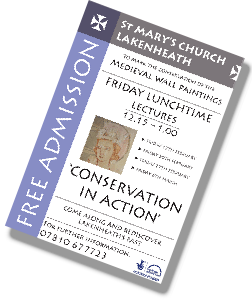
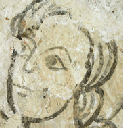
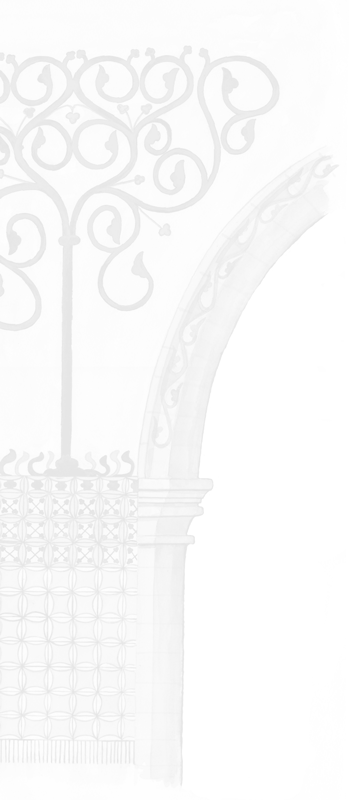
This is a copy of the realtime blog created during the main events of the project. It was designed to allow local residents who were unable to attend the weekly talks in the church to keep up to date with all the day to day events of the project. Some of the items mentioned in the original blog may now have been superceded by subsequent events and research. However, we have left the blog in its original form to give visitors an idea of how the project unfolded on a day to day level.
And in the beginning, there was the weather…
Monday 9th February—Following the awful weather of the previous week, when heavy snow actually put an end to all work on at least one day, the scaffold team from Merlin Services arrive early. Within a few hours the last of the scaffold has been put in place. It hasn’t been an easy task. The delicate state of the wall paintings has meant that no scaffold can be braced against the wall surfaces. Therefore, the whole structure has to be virtually free standing. Added to this is the fact that, just below the arcade where the vast majority of wall paintings remain, are some of the finest surviving late medieval church pews found anywhere in Suffolk. Investigation beneath the pews suggests that the timbers they are resting on are also medieval and, in turn, they rest upon a crumbling bed of lime mortar. It is imperative that we protect these wonderful items from potential harm and, as a result, have to ‘bridge’ the scaffold all the way across the pews. It’s a delicate job but the scaffold team are finished by lunchtime.
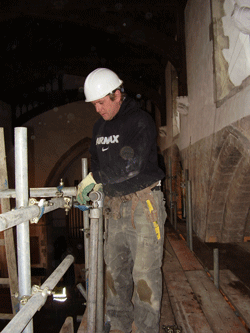
Thursday 12th February—We are very keen that the project helps visitors to the church understand the wall paintings. In particular, the three schemes on the north arcade are little more than a jumbled mess to the untrained eye. It has been decided that we will, where possible, create reconstructions of each paint scheme that can be used after the conservation is complete. In the weeks before the conservation team arrived on site we have taken dozens of photographs of each image and, working in conjunction with experts, have come up with some suggested reconstructions. Acclaimed local artist, Steve Cale, has completed the first suggested reconstruction of one of the 13th century painting schemes in St Mary’s. Click here to view the reconstruction. Although we are sure that some of the details may change as the weeks pass everyone seems very happy with the end result.
Friday 13th February—The first lunchtime lecture is held in St Mary’s. Despite more snow falling the night before, and freezing conditions that morning, over thirty hardy souls turn up to listen to a short talk on the wall paintings and the conservation work that is taking place. Lots of interest and lots of questions. Everyone, despite being rather nervous of the sudden influx of visitors, is really pleased. Bianca and Doug hide at the top of the tall scaffold whilst Mark Perry answers some very intelligent and searching questions below. The reconstruction is very well received and we are keen to get on and finish the others.
Most of the visitors, particularly those from Lakenheath itself, are very impressed with the work done on the image of the Risen Christ. It has taken nearly a week of hard work, in freezing conditions, but Mark has managed to remove the layer of wax that was applied to the surface in the 1950s. The result is stunning. Suddenly the features are clearly visible again and the brown staining has gone from the surface. The modern repairs have been removed, to be replaced with traditional materials, and the surface has been stabilised. We will post some images here on Monday.
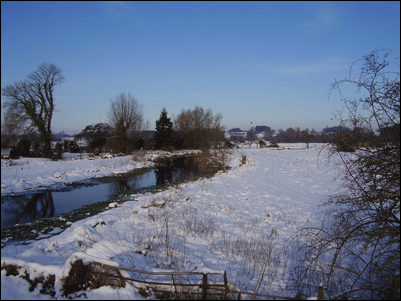
The conservation team, from Perry Lithgow Partnership, arrive on site at about ten in the morning and begin the initial photographic survey. Everything will be painstakingly recorded as we go along and a full photographic record of all interventions will be undertaken. Mark Perry, the team leader, has decided that the team will concentrate their efforts upon the 17th century text panel and the Risen Christ that lies near the Chancel arch. These should take about a week to conserve. With luck we should have the first of the scaffolds down again by the middle of the second week. We are very conscious that we are badly disturbing the day to day running of what is normally a very busy church. If we can get these scaffolds out of the way as soon as possible then the congregation will at least have half a church to worship in.
We have also been able to add a great deal more detail to what we know about the third scheme. Close examination of the upper tier of paintings, thought to represent the harrowing of hell and the resurrection, has brought to light the fragmentary remains of a hell mouth (with Adam leading Eve out of it) and two mail clad soldiers who lie sleeping outside Christ’s tomb.
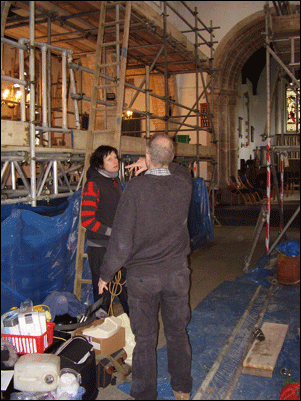
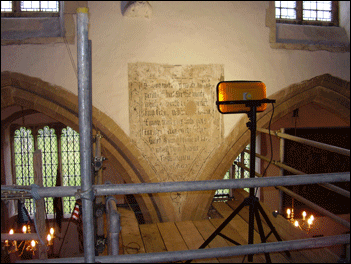
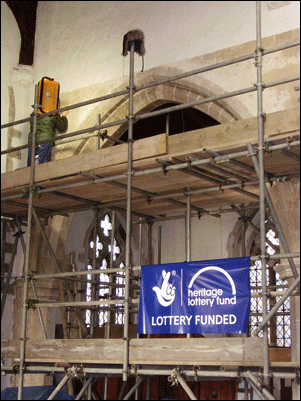
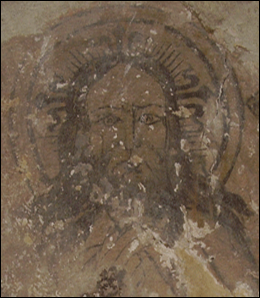
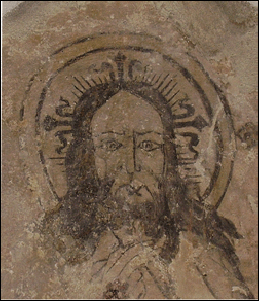
Sunday 15th February—The initial drafts have been completed for the second of the reconstructions (which represents the earliest scheme). It will need a great deal more work, and our initial inspections suggest that there were elements that we have overlooked, but the basic structure is complete. Click here to view the reconstruction.
Monday 16th February—Mark Perry is not on site this week and the direction of the conservation has been taken on by his partner Richard Lithgow. Richard took over the work on the ‘Risen Christ’ and by the end of the day it was almost complete. The final colourwashes, used to ‘tone down’ the modern repair work, were applied and we must now wait until everything is dry before going further. In addition, Bianca has almost finished work on the early 17th century text and we have arranged for that scaffold to come down first thing on Wednesday. Doug continues to work hard on the western end of the north arcade and, as the week progresses, he will gradually move towards the east. It is slow and delicate work.
We could be a little tight for time this week as we also have to work around a church service on Thursday morning and a funeral on Wednesday afternoon. The aim is to have the first scaffold out of the way before Wednesday’s funeral.
Friday 20th February—The lunchtime lecture was attended by between 20 and 25 people and everyone seemed very enthusiastic. Richard Lithgow was on site this week and gave all the visitors a thorough run through on the challenges faced by the conservation team. All work is now being concentrated on the north wall of the nave and we have spent some time examining both the structure and the content of the paintings.
Big news—Richard Lithgow spent time examining the paintings on the north wall of the nave this morning. The result is that we actually have the remains of FOUR individual schemes on the wall rather than the three we thought we had last week. There is really very little left of this newly discovered scheme and it is impossible to even suggest what it may once have shown. The few remaining fragments lie between the third scheme (that which shows St Edmund) and the reformation whitewash—suggesting a late medieval date. We are speculating that it may be part of the scheme that our image of the Risen Christ belongs to and therefore date to the 15th century.
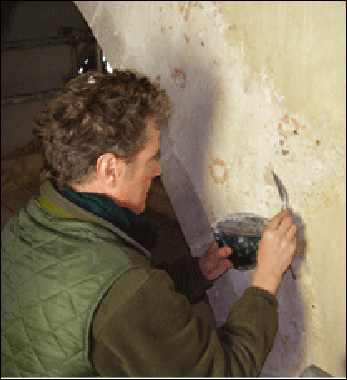
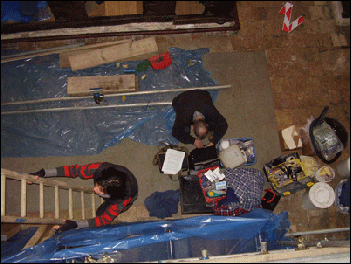
 continue
continue
Left: The face of the 15th century Risen Christ located near the chancel arch - before and after conservation. The image was the only one at Lakenheath to have received a wax coating during earlier attempts at conservation. As well as stabilising the image the conservators removed as much of the wax as possible, revealing far more detail and evidence of the original colouring.
Left: The early 17th century text on the south arcade was one of the first jobs tackled by the conservation team. Poorly executed repairs and later over-painting had made the original almost illegible.
Right: The height of the arcades and the complexity of the paint schemes meant that almost all of the inside of the church had to be scaffolded. However, with important 15th century pews located beneath the arcade the task was far from straightforward. The large beams used to bridge across the pews can be seen to the left of Bianca as Mark Perry directs operations.
